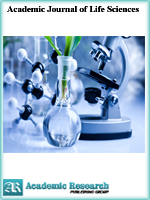Academic Journal of Life Sciences
Online ISSN: 2415-2137
Print ISSN: 2415-5217
Print ISSN: 2415-5217
Quarterly Published (4 Issues Per Year)

Archives
Volume 7 Number 3 September 2021
Predicting Population Status of Gum and Resin Bearing Plant Species from Size Distributions in Benishangul Gumuz Regional State, Ethiopia: Inferences for Their Sustainable Management
Authors: Dereje Mosissa ; Girum Faris ; Sisay Aman
Pages: 48-55
DOI: doi.org/10.32861/ajls.73.48.55
Abstract
Diversity, population structures, and regeneration status of gum- and resin-producing woody species, were assessed in 116 sample plots, each measuring 400 m2 and established along line transects. The data were collected in two selected districts, namely, Sherkole and Kurmuk in Benishangul-Gumuz National Regional State, one of the gums and resin belts in western Ethiopia. The gum- and resin-producing woody species had 1.04 and 0.7 diversity and 0.576 and 0.49 evenness values at Kurmuk and Sherkole districts, respectively. They accounted for 26% and 46% of the density, 51% and 58% of the basal area, and 32% and 53% of the Importance Value Index of all the woody species, respectively. The gum- and resin-bearing woody species exhibited three patterns of population structure. The first pattern suggests good reproduction abilities of the species coupled with a good recruitment of seedlings and their subsequent continuous growth to replace older individuals over time, indicating stable regeneration. About 61% of the gum- and resin-bearing woody species fall under this category. The other two patterns indicate the hampered regeneration status of the woody species. Heavy grazing, conversion to cropland by small-scale farming, gold mining, recurrent fire, and climate change were mentioned as major bottlenecks of natural regeneration and recruitment. Policy, extension, and research recommendations are discussed.



